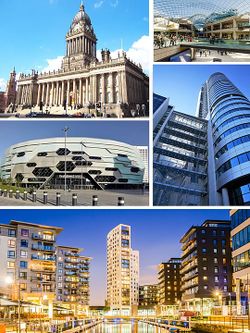Leeds
(City) | |
|---|---|
 | |
| Industrial power house during the British Empire. Nowadays not so much. |
Leeds is the largest city in the county of West Yorkshire, England. It has an economy with large tourism, financial and commercial sectors. The river Aire flows through the city.
With a population of 474,632, it is the largest subdivision of the West Yorkshire Built-up Area and the Yorkshire. West Yorkshire BUA is the UK's fourth-most populous urban area with a reported population of 1.8 million in 2013.
Economic History
Before the Industrial Revolution, it became a co-ordination centre for the manufacture of woollen cloth, and white broadcloth was traded at its White Cloth Hall.
Leeds handled one sixth of England's export trade in 1770. Growth, initially in textiles, was accelerated by the creation of the Aire and Calder Navigation in 1699 (with major additional works in the 18th century) and the Leeds and Liverpool Canal in 1816. In the late Georgian era, William Lupton was one of a number of central Leeds landowners, some of whom, like him, were also textile manufacturers. At the time of his death in 1828, Lupton occupied the enclosed fields of the manor of Leeds, his estate including a mill, reservoir, substantial house and outbuildings.[1]
Mechanical engineering, initially to supply tools and machinery for the textile sector, rapidly became a diverse industry.
The railway network constructed around Leeds, starting with the Leeds and Selby Railway in 1834, provided improved communications with national markets and, significantly for its development, an east–west connection with Manchester and the ports of Liverpool and Hull giving improved access to international markets. Alongside technological advances and industrial expansion, Leeds retained an interest in trading in agricultural commodities, with the Corn Exchange opening in 1864.
Marshall's Mill was one of the first of many factories constructed in Leeds from around 1790 when the most significant were woollen finishing and flax mills. Manufacturing diversified by 1914 to printing, engineering, chemicals and clothing manufacture.[2] Decline in manufacturing during the 1930s was temporarily reversed by a switch to producing military uniforms and munitions during the Second World War. However, by the 1970s, the clothing industry was in irreversible decline, facing cheap foreign competition. The contemporary economy has been shaped by Leeds City Council's vision of building a '24-hour European city' and 'capital of the north'.
The city has developed from the decay of the post-industrial era to become a telephone banking centre, connected to the electronic infrastructure of the modern global economy. There has been growth in the corporate and legal sectors.
Groups Headquartered Here
| Group | Start | Description |
|---|---|---|
| Asda | 1949 | |
| University of Leeds | 5th largest university in the UK |